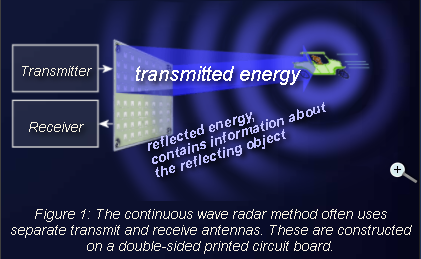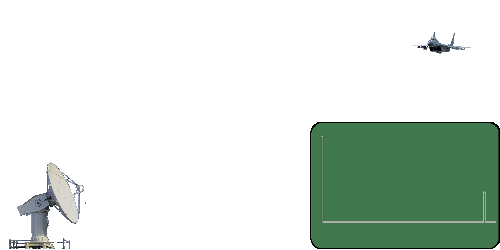Continuous wave radar
Continuous Wave Radar (CW radar) sets transmit a high-frequency signal continuously. The echo signal is received and processed permanently. One has to resolve two problems with this principle:
•prevent a direct connection of the transmitted energy into the receiver (feedback connection);
•assign the received echoes to a time system to be able to do run time measurements.
A direct connection of the transmitted energy into the receiver can be prevented by:
•the spatial separation of the transmitting antenna and the receiving antenna, e.g. the aim is illuminated by a strong transmitter and the receiver is located in the missile flying directly towards the aim;
•frequency dependent separation by the Doppler-frequency during the measurement of speeds.
A run time measurement isn't necessary for speed gauges, the actual range of the delinquent car doesn't have a consequence. If you need range information, then the time measurement can be realized by frequency modulation or phase keying of the transmitted power. A CW-radar transmitting an unmodulated power can measure the speed only by using the Doppler- effect. It cannot measure a range and it cannot differentiate between two or more reflecting objects.

If an echo signal is received, this is initially only proof that there is an obstacle in the direction of propagation of the electromagnetic waves. The properties of the obstacle can be inferred from certain properties of the echo signal. For example, the strength of the echo signal depends on the size of the obstacle. Likewise, the strength of the echo signal is a sign of whether this obstacle is far away or near the radar. (Unfortunately, no measurement result is possible from this context, since the strength of the echo signal depends on too many factors) . A change in the frequency spectrum, on the other hand, is a safer feature for certain properties. Thus, harmonics of the transmission frequency can also occur during a reflection on certain materials. This is specifically exploited in a so-called “harmonic radar” in order to use these materials, which are incorporated into protective clothing, for example, to find people buried under the masses of snow in avalanche regions. However, the most commonly used changes in the spectrum are caused by the Doppler effect.
Determining the Distance and Speed
The radar transmits a short radio pulse with very high pulse power. This pulse is focused in one direction only by the directivity of the antenna, and propagates in this given direction with the speed of light.
If in this direction is an obstacle, for example an airplane, then a part of the energy of the pulse is scattered in all directions. A very small portion is also reflected back to the radar. The radar antenna receives this energy and the radar evaluates the contained information.
The distance we can measure with a simple oscilloscope. On the oscilloscope moves synchronously with the transmitted pulse a luminous point and leaves a trail. The deflection starts with the transmitter pulse. The luminescent spot moves to scale on the oscilloscope with the radio wave. At this moment, in which the antenna receives the echo pulse, this pulse is also shown on the oscilloscope. The distance between the two shown pulses on the oscilloscope is a measure of the distance of the aircraft.
Since the propagation of radio waves happens at constant speed (the speed of light c0) this distance is determined from the runtime of the high-frequency transmitted signal. The actual range of a target from the radar is known as slant range. Slant range is the line of sight distance between the radar and the object illuminated. While ground range is the horizontal distance between the emitter and its target and its calculation requires knowledge of the target's elevation. Since the waves travel to a target and back, the round trip time is dividing by two in order to obtain the time the wave took to reach the target. Therefore the following formula arises for the slant range:


The speed of the targets is determined by the radar using a simple calculation, the distance traveled by the target divided by the time it traveled that distance.
c0 (light speed) = 300.000 km/s ; t=delay time [s] ; R = inclined distance [m] ;
The distances are expressed in kilometers or nautical miles (1 NM = 1.852 km).